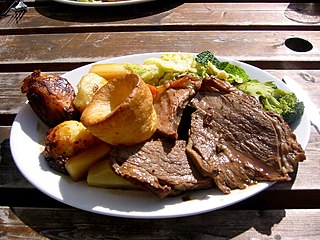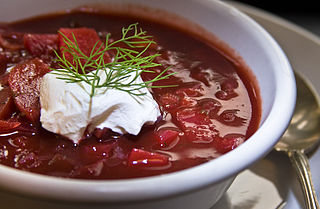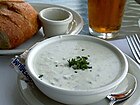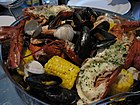
Corned beef, bully beef, or salt beef in some Commonwealth countries, is salt-cured brisket of beef. The term comes from the treatment of the meat with large-grained rock salt, also called "corns" of salt. Sometimes, sugar and spices are added to corned beef recipes. Corned beef is featured as an ingredient in many cuisines.

Rutabaga ; North American English) or Swede is a root vegetable, a form of Brassica napus. Other names include Swedish turnip, neep (Scots), and turnip. However, elsewhere, the name "turnip" usually refers to the related white turnip. The species Brassica napus originated as a hybrid between the cabbage and the turnip. Rutabaga roots are eaten as human food in various ways, and the leaves can be eaten as a leaf vegetable. The roots and tops are also used for livestock, fed directly in the winter or foraged in the field during the other seasons. Scotland, Northern and Western England, Wales, the Isle of Man, and Ireland had a tradition of carving the roots into Jack-o'-lanterns at Halloween.

A Sunday roast or roast dinner is a traditional meal of British origin. Although it can be consumed throughout the week, it is traditionally consumed on Sunday. It consists of roasted meat, roasted potatoes, mashed potatoes and accompaniments such as Yorkshire pudding, stuffing, gravy, and condiments such as apple sauce, mint sauce, or redcurrant sauce. A wide range of vegetables can be served as part of a roast dinner, such as broccoli, Brussels sprouts, cabbage, carrots, cauliflower, parsnips, or peas, which can be boiled, steamed, or roasted alongside the meat and potatoes.

Borscht is a sour soup, made with meat stock, vegetables and seasonings, common in Eastern Europe and Northern Asia. In English, the word borscht is most often associated with the soup's variant of Ukrainian origin, made with red beetroots as one of the main ingredients, which give the dish its distinctive red color. The same name, however, is also used for a wide selection of sour-tasting soups without beetroots, such as sorrel-based green borscht, rye-based white borscht, and cabbage borscht.

Brisket is a cut of meat from the breast or lower chest of beef or veal. The beef brisket is one of the nine beef primal cuts, though the definition of the cut differs internationally. The brisket muscles include the superficial and deep pectorals. As cattle do not have collar bones, these muscles support about 60% of the body weight of standing or moving cattle. This requires a significant amount of connective tissue, so the resulting meat must be cooked correctly to tenderise it. According to the Random House Dictionary of the English Language, Second Edition, the term derives from the Middle English brusket which comes from the earlier Old Norse brjósk, meaning cartilage. The cut overlies the sternum, ribs, and connecting costal cartilages.

Polish cuisine is a style of food preparation originating in and widely popular in Poland. Due to Poland's history, Polish cuisine has evolved over the centuries to be very eclectic, and shares many similarities with other national cuisines. Polish cooking in other cultures is often referred to as à la polonaise.

Russian cuisine is a collection of the different dishes and cooking traditions of the Russian people as well as a list of culinary products popular in Russia, with most names being known since pre-Soviet times, coming from all kinds of social circles.

Ukrainian cuisine is the collection of the various cooking traditions of the people of Ukraine, one of the largest and most populous European countries. It is heavily influenced by the rich dark soil (chornozem) from which its ingredients come, and often involves many components. Traditional Ukrainian dishes often experience a complex heating process – "at first they are fried or boiled, and then stewed or baked. This is the most distinctive feature of Ukrainian cuisine".

Pennsylvania Dutch cuisine is the typical and traditional fare of the Pennsylvania Dutch.

Colcannon is a traditional Irish dish of mashed potatoes with cabbage. It is a popular dish on Saint Patrick's Day and on the feast day of St. Brigid.

Belarusian cuisine refers to the culinary traditions native to Belarus. It shares many similarities with cuisines of other Eastern, Central and Northeastern European countries, based predominantly on meat and various vegetables typical for the region.

Jiggs dinner, also called boiled dinner or cooked dinner, is a traditional meal commonly prepared and eaten on Sundays in Newfoundland. Corned beef and cabbage was the favorite meal of Jiggs, the central character in the popular, long-running comic strip Bringing Up Father by George McManus and Zeke Zekley.
Bukharan Jewish cuisine is the traditional cuisine originating from the Bukharian Jewish community of Central Asia, who now mostly reside in Israel, and the United States.
Hodge-podge or hotch potch is a soup or stew, usually based on diced mutton or other meat, with green and root vegetables. It is familiar in different versions in Britain and North America and is particularly associated with Scotland.

The Maritimes consist of the provinces of New Brunswick, Nova Scotia and Prince Edward Island. Some of the cuisine has its origins in the foods of the indigenous peoples of the region.

Bacon and cabbage is a dish traditionally associated with Ireland. The dish consists of sliced back bacon boiled with cabbage and potatoes. Smoked bacon is sometimes used.

Cocido or cozido is a traditional stew eaten as a main dish in Spain, Portugal, Brazil and other Hispanophone and Lusophone countries.

A stew is a combination of solid food ingredients that have been cooked in liquid and served in the resultant gravy. Ingredients can include any combination of vegetables and may include meat, especially tougher meats suitable for slow-cooking, such as beef, pork, venison, rabbit, lamb, poultry, sausages, and seafood. While water can be used as the stew-cooking liquid, stock is also common. A small amount of red wine or other alcohol is sometimes added for flavour. Seasonings and flavourings may also be added. Stews are typically cooked at a relatively low temperature, allowing flavours to mingle.



















